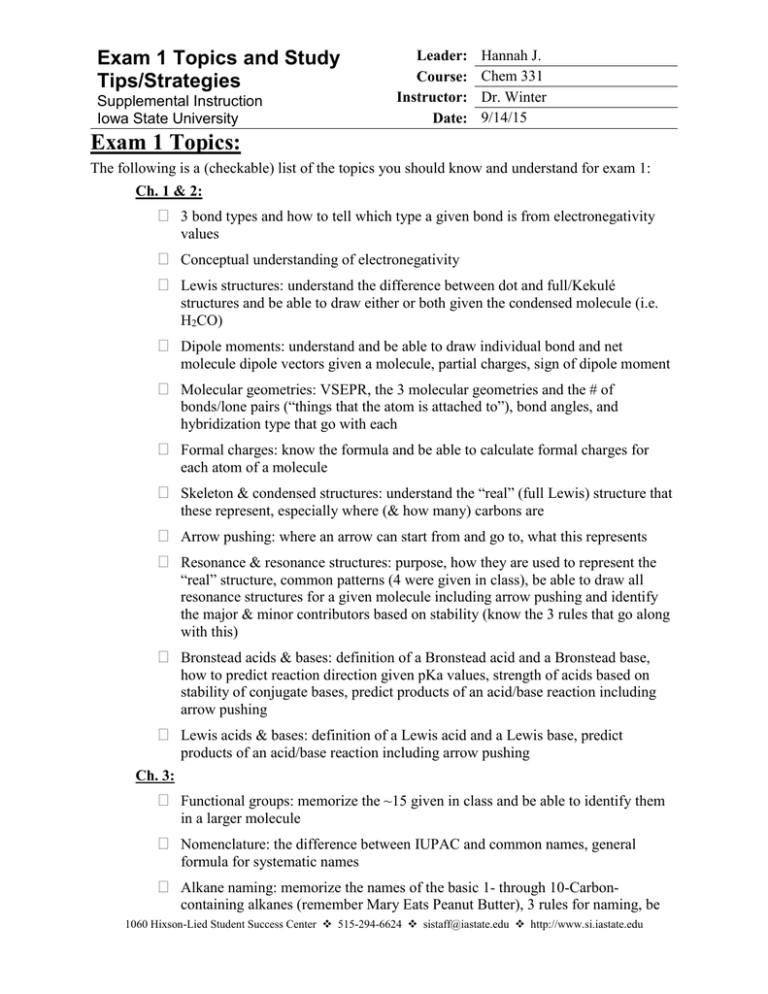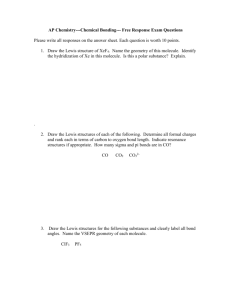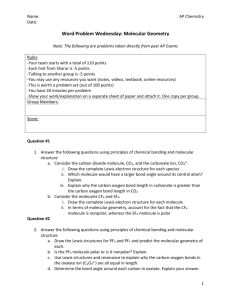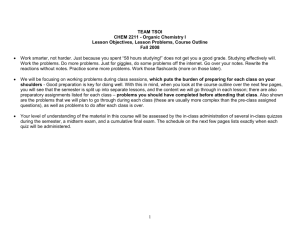Exam 1 Topics and Study Tips/Strategies
advertisement

Exam 1 Topics and Study Tips/Strategies Supplemental Instruction Iowa State University Leader: Course: Instructor: Date: Hannah J. Chem 331 Dr. Winter 9/14/15 Exam 1 Topics: The following is a (checkable) list of the topics you should know and understand for exam 1: Ch. 1 & 2: 3 bond types and how to tell which type a given bond is from electronegativity values Conceptual understanding of electronegativity Lewis structures: understand the difference between dot and full/Kekulé structures and be able to draw either or both given the condensed molecule (i.e. H2CO) Dipole moments: understand and be able to draw individual bond and net molecule dipole vectors given a molecule, partial charges, sign of dipole moment Molecular geometries: VSEPR, the 3 molecular geometries and the # of bonds/lone pairs (“things that the atom is attached to”), bond angles, and hybridization type that go with each Formal charges: know the formula and be able to calculate formal charges for each atom of a molecule Skeleton & condensed structures: understand the “real” (full Lewis) structure that these represent, especially where (& how many) carbons are Arrow pushing: where an arrow can start from and go to, what this represents Resonance & resonance structures: purpose, how they are used to represent the “real” structure, common patterns (4 were given in class), be able to draw all resonance structures for a given molecule including arrow pushing and identify the major & minor contributors based on stability (know the 3 rules that go along with this) Bronstead acids & bases: definition of a Bronstead acid and a Bronstead base, how to predict reaction direction given pKa values, strength of acids based on stability of conjugate bases, predict products of an acid/base reaction including arrow pushing Lewis acids & bases: definition of a Lewis acid and a Lewis base, predict products of an acid/base reaction including arrow pushing Ch. 3: Functional groups: memorize the ~15 given in class and be able to identify them in a larger molecule Nomenclature: the difference between IUPAC and common names, general formula for systematic names Alkane naming: memorize the names of the basic 1- through 10-Carboncontaining alkanes (remember Mary Eats Peanut Butter), 3 rules for naming, be 1060 Hixson-Lied Student Success Center 515-294-6624 sistaff@iastate.edu http://www.si.iastate.edu able to draw structures given the name or vice versa, memorize the 3 commonnamed complex substituents given in class Isomers: definition, be able to draw different isomers given a formula Conformations/Newman Projections: understand that atoms can spin around a single bond, what a conformation is, and the purpose of Newman projections, be able to draw Newman projections for any (relatively short) hydrocarbon, know the 2 (for ethane) or 4 (for propane and beyond) conformations and which is the highest and lowest energy and why (based on the 2 types of strain) Ch. 4: Cycloalkanes: o What they all contain (a hydrocarbon ring) o Naming (follows same rules as for alkane naming except with a – cyclo-), how to decide if the ring or the straight-chain is the parent chain, how to number the ring’s carbons based on substituents (if the ring is the parent chain), trans vs. cis stereoisomers o Angle strain: what it is, why it occurs, and what it means for smaller cycloalkanes and which cycloalkane is the most stable, chair conformations Note: Each student is also responsible for any new material covered in class on Monday, 9/14/15 that Dr. Winter says will be on the exam (not included in this list). Study Tips/Strategies: Go through your notes, reading them and highlighting important topics and details (This is a good first step in studying for any exam. If you don’t have good notes, ask a friend.) Redo in-class examples and/or SI worksheets without looking at the solutions, then check your work Do end-of-chapter problems (Ch. 1-4) in textbook Read end-of-chapter summaries and passages on confusing topics in textbook Form a study group and study together Make flashcards for the memorized items and go through them until you can identify the name given the structure/functional group or vice versa in any order on the first try Finish all applicable Sapling homework & look back through past assignments Come to SI DO THE PRACTICE EXAM POSTED ON BLACKBOARD (if it’s helpful to you, consider taking it once without studying to gauge where you are, then retake it after studying) Ask a friend, me (your SI leader), or Dr. Winter in person or via email about any topics that you are still confused on after studying Power through and don’t forget to breathe! If you’ve been putting in the effort and gotten a good grasp on the material, you’ll be successful on the exam—you can do it!






